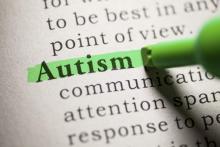Estimated prevalence of autism spectrum disorder among 4-year-olds falls short of the estimated prevalence among 8-year-olds in a recent study comparing nationally representative age cohorts.
“Because previous reports indicate that many children with ASD are not evaluated until after age 4, ASD prevalence in this 4-year-old age cohort will likely rise when measured at a later age,” Deborah L. Christensen, Ph.D., of the Centers for Disease Control and Prevention, and her associates reported. “Lowering the age at first evaluation may be more relevant than lowering the age at diagnosis given the challenges of diagnosing young children with ASD,” they wrote (J Dev Behav Pediatr. 2016 Jan;37[1]:1-8).
The investigators screened health and education records for all 4-year-old and 8-year-old children participating in 5 of the 11 sites involved in the 2010 Autism and Developmental Disabilities Monitoring Network, an active surveillance system for identifying 4-year-olds with ASD. The authors looked for an ICD billing code and/or special education data that included an ASD diagnosis or a description of “behavior consistent with ASD.”
They then compared autism prevalence, cognitive test scores, demographics, and ages of evaluation and ASD diagnosis among the 58,467 4-year-olds and 56,727 8-year-olds assessed, each cohort representing approximately 1.4% of those age groups in the 2010 U.S. population.
Prevalence of ASD among 4-year-olds was 13/1,000 children overall, approximately 30% lower than prevalence estimates for 8-year-olds and ranging from a low of 9/1,000 in Missouri to a high of 20/1,000 in New Jersey. Other states involved in the analysis included Arizona, Utah, and Wisconsin. Prevalence was significantly higher in states with both education and health records available than in those states with only health records available.
At all five sites, boys significantly proportionally outnumbered girls in ASD diagnosis. Overall, three boys had ASD for every one girl with ASD, but the ratio varied from 2.6 in Arizona, Missouri and Wisconsin to 4.4 in New Jersey. Despite no overall difference in ASD prevalence by race/ethnicity among 4-year-olds, white 8-year-olds had 1.4 times greater prevalence than that among black children and 1.2 greater prevalence than that among Hispanic children the same age.
Among the 70% of children in Arizona, New Jersey, and Utah who had data on cognitive assessments, 46% of 4-year-olds and 28% of 8-year-olds had cognitive impairment, defined as a score of 70 or lower. Prevalence of both ASD and cognitive impairment among 4-year-olds was 6/1,000 children, compared with 5/1,000 children among 8-year-olds. Prevalence of ASD without cognitive impairment was 7/1,000 among 4-year-olds and 12/1,000 among 8-year-olds.
A history of developmental concerns before 3 years old existed for 93% of the 4-year-olds and 87% of the 8-year-olds with ASD. In addition, 71% of the 4-year-olds and 43% of the 8-year-olds had received their first comprehensive evaluation by 36 months.
The research was funded by the Centers for Disease Control and Prevention. Dr. Christensen and her associates reported no disclosures.


